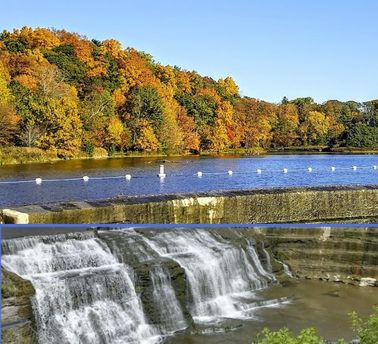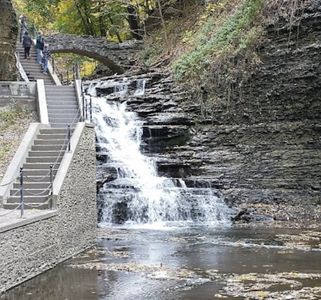
Ithaca is one of the few cities in the state of New York that has the most waterfalls within its urban core. One of these waterfalls is the Triphammer falls. Triphammer Falls is situated on Fall Creek within Ithaca, New York. It is a fifty-five feet long waterfall, and its exact location falls within the Cornell University campus. Triphammer Falls existed naturally but was altered to a large extent in the 19th century due to dam building. This led to the creation of Beebe lake just over the waterfall. Today, this waterfall is the centerpiece of the campus of Cornell University.
History
Ezra Cornell constructed a dam on Fall Creek, just over Triphammer Falls, in 1838. He created this dam to provide water to Jeremiah S. Beeb’s mills. Cornell started the damn by creating a tunnel to channel the water from the falls. The tunnel was fifteen feet high and two hundred feet long and raised the water level by eighteen feet. The damn was increased by ten feet, turning into a good lake. This lake is dredged once every decade to prevent it from returning to its initial wetland state.
In the 1890s, Beebe lake was also used as a central recreation spot. It was open to the public for ice skating and was maintained by the Cornell Athletic Association. This lake was also used as the main venue for Cornell’s ice hockey matches during the very first decade of the sport.
Triphammer falls were named after the Triphammer forge in the area in the 1820s.
The Details

Ithaca, New York, has a large number of waterfalls because three major water courses bisect significant parts of the area. Fall Creek is the northernmost watercourse, and it flows through a vast gorge located in the center of Cornell University. It then drops over five different waterfalls within less than a mile.
Triphammer Falls is the first of the five significant falls from this Fall Creek Gorge. Fall creek also serves as the most important tributary that falls to Cayuga Lake. Water in the lake drains from a basin about one hundred and thirty sq. miles. Water flow is all year long, but the volume varies according to season. The diversion of the flow of water created through the Beebe dam also affects the importance of the creek’s water and reduces it by at least half. By the end of summer, the stream flow is usually half what it is in the wet season. But there is still enough water for the water to be boastful.
However, visiting Beebe lake today is serene and peaceful. It serves as a beautiful escape from the busy Cornell University city campus. The lake stretches along the course of seven miles. The natural area around the lake is full of varied wildlife and plants. Beebe lake has been used for many different purposes through the years. It has been used for swimming lessons and ice hockey. It has also been used for educational studies on hydraulics and ecology.
Visiting Triphammer Falls
Triphammer Falls is open from dawn till dusk. There is no fee charged for visiting the falls. Swimming is prohibited in the falls. Dogs are allowed, albeit they need to be kept on a leash at all times. You can view the falls from the Triphammer Foot Bridge or the East Ave. Bridge. It’s also possible to hike to the falls. You can use the trailhead to the north rim located behind Risley Hall.
This urban waterfall is one of the several Falls located on Falls Creek. Triphammer Falls is right at the center of the city. It is formed in two drops; however, the first drop is partially obscured due to the creation of the dam that forms Beebe lake. But you can view the lower half from East Ave. Bridge. There is also an old, abandoned power station at the base of the Triphammer waterfalls. This is quite an exciting feature of this waterfall.
Ithaca Falls is located a mile downstream from Triphammer Falls. This region has several other waterfalls, such as Lucifer Falls and the Buttermilk Falls State Park. Taughannock Falls is located a few minutes north of Lucifer falls. Other waterfalls like Eagles Nest falls, Montville Falls, Watkins Glen, and Hector Falls, amongst many others are also located within one hour’s drive.
How To Get There?
To get to Triphammer Falls, take highway thirty-four from downtown Ithaca. You should get off the freeway to East Shore Drive. When on East Shore Drive, turn southward and continue for a little more than a mile till you reach the Stewart Avenue intersection. Continue on Stewart Avenue till you reach University Avenue. Keep going one another one-third of a mile till you come to Thurston Avenue.
On Thurston Avenue, go left and cross the bridge over Fall Creek. Triphammer Falls is located upstream. You might have to park in a public parking lot away from the stream and walk as parking spots are limited.
Concluding Thoughts
Ithaca is a great city to explore if you love being around nature and water. There are approximately one hundred and fifty waterfalls within a ten-mile area. Ithaca is known for its abundant urban waterfalls. Triphammer falls one of the first waterfalls created from water flowing from Fall Creek. Located at the center of Cornell University, anyone can visit this site. You can also view Beebe lake, the artificially created dam that formed into a lake due to its large amount of water. Ezra Cornell built this dam to channel water into nearby mills.
Visiting Triphammer falls is a unique and serene experience. You can relax, enjoy the peaceful nature offers, and be rejuvenated by the surrounding greenery. It’s a great place to visit and easily accessible from within the city.
